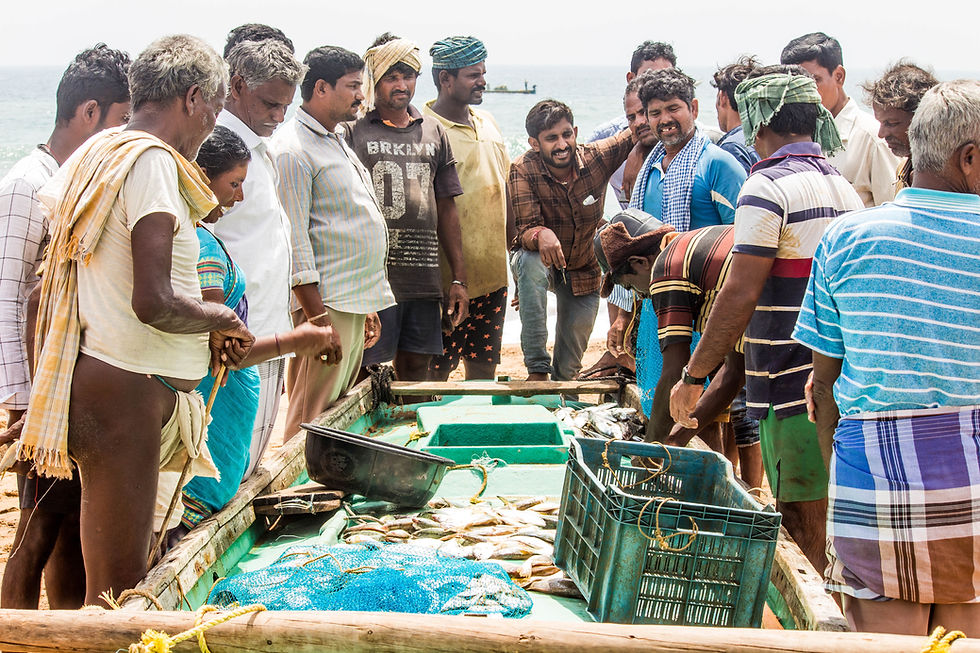Planning to turn vegan? Honestly, it’s not easy
- Oct 12, 2020
- 3 min read
Vegans claim their concern for the environment makes them choose this lifestyle, but others often find it too expensive and unsustainable
Bhavya Vemulapalli

Fisher’s price negotiations
(Photo Credits: Bhavya Vemulapalli)
Sukhjot Kaur, a pastry chef from Singapore, tried to be a vegan for a few months but found it a tough challenge.
“Honestly, it is not easy,” added Kaur, who has been a vegetarian all her life.
“Veganism requires patience because it is not a big thing in countries like India,” she said. “There are very few alternatives to a traditional diet outside metropolitan cities.”
Kaur said one needs to do one’s research before choosing such a lifestyle, which is both challenging and expensive.
“It is important to include protein foods such as beans, yogurt, soy, and almond milk, and make sure you take proper supplements for Vitamin B12,” she added. “I am not a nutritionist nor an expert but I learned from my experiences.”
Veganism, as Kaur and many others point out, is an expensive lifestyle choice not suitable for everyone.
Those who follow a diet abjuring any animal-based food products claim that meat is the biggest contributor to greenhouse gas emissions. While this might be true, a vegan diet, too, harms the environment.
For instance, almond milk is a much-sought-after product for vegans. Producing almond milk consumes huge amounts of water, leading to scarcity. In India, finding alternatives to traditional food is a major challenge, especially in rural areas, said Anjali Karasi, a nutritionist who worked with a dietician for a few months before joining the Academy of Pastry & Culinary Arts, Bengaluru.
“In rural areas, it is not only hard to find vegan alternatives, but it is costly and unsustainable if we want a ‘balanced diet’,” she said. She added that research has shown how veganism could potentially harm physical as well as mental health if not followed properly.
“Moderation is the key to sustainability,” added Karasi.
“Vegan diets are naturally low in iron, Vitamin D, and especially Vitamin B12,” said pastry chef Kaur
Fish, on the other hand, is an excellent source of Vitamin B12.
Fishing is a major occupation in India, especially in the southern states. In 2019-20, fisheries in India employed 145 million people, contributing 1.07 percent of the gross domestic product, and earned Rs 333.41 billion, according to a recent report of the National Fisheries Development Board.
While fisheries are ushering in a “blue revolution”, traditional fishers still go out to sea in many parts of India.
One such place is Chintapalli, a town in the Visakhapatnam district of Andhra Pradesh. Right on the Bay of Bengal, it is famous for its beaches, often dotted with fishers and their boats. Most of these fisherfolks, called Matsyakarulu in the Telugu language are from Besta and Mutrasi, both traditional fisherfolk castes in Andhra Pradesh. They come under the OBC (Other Backward Class) category, which comes under Visakhapatnam’s tribal population of almost 15% out of its total population.
Their average daily earning is about Rs. 300 — hardly enough to sustain a family of four. They very often consume the fish their nets catch.

“Stitching Lives Together takes time, a lot of time like the fishnet stitching does”, says
M. Tatarao, the one in the left!”
(Photo Credits: Bhavya Vemulapalli)
“Preparing for the sea is what keeps us going. We either sell the fish or eat them,” said M Tatarao, one of the fishers. “We know nothing other than this profession.”
It can take Tatarao up to 8 hours a day to stitch a net. About 10 people share the average daily earning of Rs. 1,500 from the boat’s catch. Fish often serves as extra nutrition for them.
“We eat the leftover fish most of the time, and when we earn nothing on a specific day, water is what we rely on,” said a woman from the community who was unwilling to share her name.
For most of them, veganism and its concerns for the environment are unfeasible.
“We hardly get three full meals a day for our family, and now you want us to care for the environment,” said another fisherman, who had just returned from sea.
But it is not only poor fishers who cannot afford vegan food. Many people in cities also find it expensive and unsustainable.
“As a student, I find it expensive to buy vegan alternatives such as soy milk or soy yogurt regularly,” said Shruti, a student from Vijaywada.
“I have been a meat-eater throughout my life and my vegan trial roughly lasted a week or two last December,” she added. “I never felt bad for the dead chicken on my plate.”
Sonali Purewal, an animal-loving environmentalist said, “People choose to ignore the cruelty angle of the industry. It’s completely based on perception and we see packages of happy animals on the products and negate the fact that large machines are used to extract milk from animals. The fact is that nothing is natural and there is also nothing known as cruelty-free meat.”
Edited by Vedangshi Roy and Aviva Baig


Comments